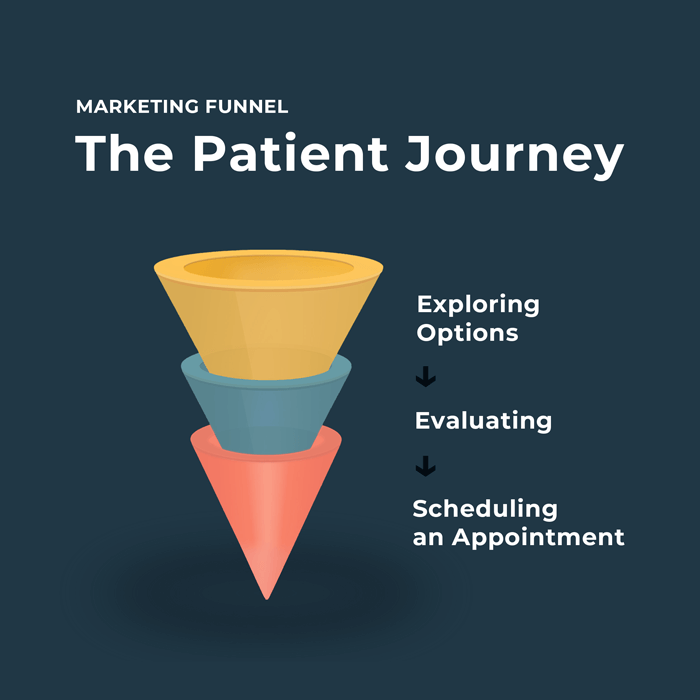If you’re in charge of inbound marketing for healthcare, you know how effective this tactic can be when it’s done right.
Instead of bombarding your audience with messaging when they don’t ask for it, such as with advertising or cold calling, inbound marketing leads your patients “in.” They ended up on your website because you provided the helpful, educational content and other healthcare marketing assets they wanted when they were looking for it.
A good strategy for inbound marketing for healthcare builds trust and credibility, ultimately increasing brand awareness, customer engagement, and inbound patient lead generation.
If you’re a healthcare marketer needing tips to become an expert at inbound tactics, you’ve come to the right place. This article will give you a great foundation for success in healthcare inbound marketing.
What does audience persona research for inbound marketing involve?
The first step in developing successful inbound marketing for healthcare strategy is developing an audience persona.
An audience persona is a fictional representation of an idealized profile of your target audience. The persona you create encapsulates your target audience’s behaviors, needs, and preferences. Knowing and deeply understanding your audience persona helps you to better empathize with your target customers, making your marketing efforts more impactful and effective.
Building an accurate audience persona to support healthcare lead generation takes time and research. Here’s how we recommend you do it:
- Collect data
- Tailor your message
- Address diverse patient needs (and expectations)
Collect data: There are several ways to collect data for your audience persona.
You could conduct surveys and interviews with your audience or analyze healthcare data. You could utilize social media and other online behavior analytics to determine audience needs and pain points.
Whatever method you choose to gather data, consider the ethical considerations and privacy compliance.
Tailor your message: Once you’ve identified your healthcare inbound marketing audience persona using data-gathering methods, create a healthcare content marketing strategy based on your insights.
Tweak your messaging according to what you learned. Your research will tell you the social media channels your audience typically spends time on and how they like to be engaged.
Develop content for each persona group based on what people in this target audience want and need. Being purposeful and intentional with your content and healthcare inbound tactics will increase their engagement with you.
Address diverse patient needs (and expectations): You will likely learn about the diverse needs of your healthcare inbound marketing target audience during your research. Developing inclusive and customized content for each audience is essential, considering their backgrounds, desires, and pain points.
Lessons from Johns Hopkins Medicine’s use of inbound marketing
Johns Hopkins Medicine successfully developed a marketing approach to diverse audiences.
Wanting to deepen its engagement with each segment of its audience, Johns Hopkins Medicine did a deep-dive study of its patient base. They conducted focus groups and analyzed their social media metrics to understand each demographic’s varying needs better. Their research uncovered distinct patient segments, each requiring a different and specific communication style.
Johns Hopkins Medicine developed targeted marketing campaigns and healthcare programs that addressed the needs of each segment. This approach increased patient outreach, produced higher patient satisfaction, and resulted in higher retention rates.

How to create a content mapping strategy for healthcare inbound marketing
An essential part of inbound marketing for healthcare is content mapping. Content mapping is a strategic planning process that involves aligning your content with the different stages of the buyer’s journey or customer lifecycle.
This type of patient journey marketing aims to deliver relevant and valuable content to your audience at each stage of their interaction with your brand, from initial awareness to conversion. Tips for creating engaging and relevant content for each persona include:
- Address pain points and challenges
- Diversify content formats
- Optimize for search engines
- Promote user engagement
- Stay authentic
Address pain points and challenges: When it comes to relationship marketing in healthcare, developing content that directly addresses each persona’s challenges and pain points is a must. Typically, this means offering solutions and providing guidance relevant to their specific needs.
Diversify content formats: Consider how different target audiences want to consume their content. Some may read blog posts, while others prefer videos, infographics, or podcasts.
Optimize for search engines: Follow SEO-related medical website design tips (and best practices) and write copy using the right words (using keyword research) to ensure your inbound content is discoverable by patients using search engines to find resources.
Promote user engagement: Encourage interaction and engagement by incorporating elements like polls, surveys, or calls to action in your content.
Stay authentic: Be genuine in your communication. Address your audience persona with honesty and transparency. This will help build trust.
Feedback from your audience persona is vital with inbound marketing for healthcare. Actively seek feedback from your audience by using comments, interviews, or social media interactions to understand how well your content meets their needs.
You can adjust your messaging and approach based on what you learn if necessary.
Customizing content for inbound healthcare marketing
Inbound digital marketing for healthcare includes authoritative, credible content customized to a target audience.
Producing diverse content involves creating highly shareable infographics that simplify complex information, developing video content that serves as tutorials, interviews, demonstrations, or hosting webinars or live events that allow for real-time interaction and Q&A sessions.
You must balance educational and promotional content to gain healthcare marketing benefits. Assets that provide value are critical to establishing trust. Authentic storytelling is a powerful way to share your impact by highlighting a positive patient experience.
Takeaways from Indiana Hand to Shoulder Center’s success with inbound marketing for healthcare
Indiana Hand to Shoulder Center is a healthcare marketing example using a multi-faceted inbound strategy.
The organization’s digital resources, from downloadable assessments and doctor videos to first-person patient stories and educational guides, provide detailed information on various conditions and treatments for hand, wrist, elbow, and shoulder care for existing patients and those who need care and are looking for a new provider.
With organic social media posts and paid ads, the IHTSC marketing team uses the organization’s marketing content to reach people in its target audience who are looking into their care options.
Furthermore, the marketing staff shares helpful informational articles on the IHTSC blog to build brand awareness, engage the community, and build trust.
Ideas for promoting assets developed for inbound healthcare marketing campaigns
Once you’ve developed your customized, engaging healthcare content, it’s time to promote it. Utilize organic and paid channels to distribute your content to your audience. Use social media best practices to encourage engagement and search engine optimization tactics to increase your content’s visibility and reach.
Create paid campaigns with keyword research, compelling ad copy, and eye-catching visuals to promote healthcare content. Consider targeting options and A/B testing to determine what approach speaks to your audience the most.
You could also examine case studies of successful content promotions and apply their approaches and healthcare marketing ideas to your audience.
Measuring inbound healthcare marketing success
Analytics provide a comprehensive understanding of how marketing efforts contribute to business goals (and they can also help you avoid healthcare marketing challenges).
Key performance indicators such as website traffic, conversions, and click-through rates provide quantitative measures of marketing success. The real-time data allows marketers to monitor ongoing campaigns and make immediate adjustments and data-informed decisions.
Take time to bring it all together
Being successful with inbound marketing takes dedication and strategy.
This complex work always begins with setting goals, completing blueprint planning, and creating patient personas so that you can establish a healthcare marketing budget that will support this work. Only after this initial planning is complete can you develop customized content to support the patient customer journey and effectively promote those assets to all of the people in your target audiences.
But the work doesn’t stop there. To ensure continued progress, you must track your efforts using data and analytics to assess what’s working and what’s not so that you can adjust accordingly. For some organizations, their healthcare marketing experts can pull all of this off on their own. Others choose healthcare marketing groups to support their work.
Choose a partner with expertise in healthcare inbound marketing
If you need to refine your inbound marketing for healthcare strategy but don’t know where to start, the experts at TBH Creative—one of the country’s leading healthcare internet marketing firms—can help. We’ve been helping with inbound lead generation for healthcare since 2004, and we have the healthcare marketing skills needed to boost patient engagement and grow conversions.
Ready to put the right content to work for the right audience? Contact us, and let’s start planning healthcare marketing and branding designed to support your goals.

